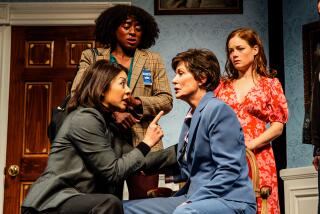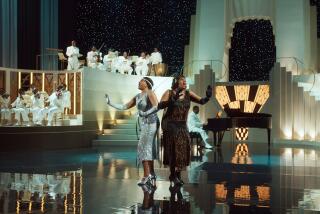MUSIC AND DANCE REVIEWS : ‘Awed Behavior’ Redlines at Royce
- Share via
Take a pair of symbolic characters already burdened with a full freight of poet/novelist, male/female, right-brain/left-brain dichotomies, drape them with increasing associations with Percy and Mary Shelley and watch the pretensionometers redline.
That was the case Saturday at Royce Hall, UCLA, when the Paul Dresher Ensemble brought “Awed Behavior”--a duo-drama submerged in self-conscious conceptualization--in for a one-night stand.
Arlyss and Jane are the Percy-Shelley representatives, although any resemblance to real people, historical or fictional, is more a matter of satiric pose than of actual characterization. As Jane might say in one of her story-line announcements: Boy meets girl, boy gets girl, boy drifts off into semiotic wasteland.
Of course, they are really complementary halves of a whole, as Dresher’s music, Rinde Eckert’s direction and Sandra Woodall’s costumes all remind us, however loudly Eckert’s script is engaged in dialectical strife. The equation of the poet with Mary Shelley’s monster is superficial, however, and any sense of loss when rhyme leaves reason is due to Shelley’s own writing and the beautiful low-tech effects of designer Alexander Nichols.
With all the best songs, Amanda Moody’s Jane grew in presence as she must, taking over the show from the point of the sleep-walking tango, a seductively bittersweet ode to illusion and imagination. Opposite her, J. Spence Stephens Jr. struggled with pitch and ultimately a malfunctioning body-mike.
Singing or speaking, both delivered Eckert’s words cleanly and moved with assurance in Eckert’s very physical staging, which like his libretto seldom found any workable ground between obviousness and obscurity.
Dresher’s pluralistic, layered score provided a firmly rooted, sophisticated anchor. Effectively exploited electronics added depth to the tight playing of a four-piece ensemble, positioned behind Nichols surprise-filled, raked unit set.
The evocative interludes and night music were mainly the work of keyboardist extraordinaire Phil Aaberg and Dresher himself on guitar. Paul Hanson’s sax and bassoon took over in the wailing groove Dresher set up for the masquerade and in most of the sung portions, pertinently goosed by percussionist Gene Reffkin.
More to Read
The biggest entertainment stories
Get our big stories about Hollywood, film, television, music, arts, culture and more right in your inbox as soon as they publish.
You may occasionally receive promotional content from the Los Angeles Times.










